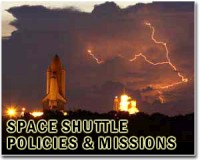 |
Pasadena CA (SPX) Apr 29, 2011 In addition to astronauts, Endeavour will carry a legion of microscopic passengers in the Planetary Society's Shuttle LIFE experiment when the space shuttle launches on its last flight on April 29. Can life naturally transfer from planet to planet? LIFE, the Living Interplanetary Flight Experiment, will test aspects of the transpermia hypothesis - the ability of microbial life to survive an interplanetary voyage. The largest of the LIFE organisms launching on the shuttle will be tardigrades, or water bears, which are no bigger than the head of a pin. Shuttle LIFE will serve as a test run for Phobos LIFE, a larger collection of organisms that the Planetary Society will send on a three-year trip aboard a Russian spacecraft to the Martian moon Phobos and back to Earth in a capsule that will simulate a meteoroid. Phobos LIFE is set to launch at the end of 2011. "One cannot help but wonder if it's possible for a living organism to make the trip from one planet to another?" said Bill Nye, Executive Director of the Planetary Society. "How about from Mars to the Earth?" To better understand the process of sending microorganisms to space and back, the Planetary Society is going to first launch some of the LIFE sample tubes into Earth orbit aboard Endeavour.
Shuttle Life's Main Goals + Testing the effects of low Earth orbit spaceflight on the organisms, + Providing a comparison for the upcoming long duration Phobos LIFE mission, + Serving as a "dress rehearsal" for Phobos LIFE, complete with loading, unloading, and analyzing organisms in laboratory conditions, and + Engaging the public in the exciting discussion of whether life might be able to travel naturally between planets. Over 14 days, Shuttle LIFE will test the effects of low-Earth orbit spaceflight on five diverse species of microorganisms packed in tiny, heat-sealed, Delrin plastic sample tubes. For the Phobos mission, the miniature sample tubes will be packed into a nearly indestructible titanium capsule that looks like a small hockey puck. The five life forms being flown in Shuttle LIFE are Tardigrades; the bacteria Deinococcus radiodurans and Bacillus subtilis; and the archaea Haloarcula marismortui and Pyrococcus furiosus. A passenger manifest explains what characteristics of the different microorganisms - such as resistance to radiation or extreme hardiness - made them good choices for space travel. "The millions of tiny space voyagers in Shuttle LIFE are set to take a big journey and give us information about life in space, and they'll do it all without any checked baggage," said Bruce Betts, the Planetary Society's Director of Projects.
Partners For Shuttle Life Shuttle LIFE will fly in a flight-proven unit from Instrumentation Technology Associates, Inc. (ITA) as part of CREST-1 (Commercial Reusable Experiments for Science and Technology), manifested on STS-134 through NanoRacks LLC, working in partnership with NASA.
Share This Article With Planet Earth
Related Links the Planetary Society STS-134 Mission Summary (357 Kb PDF) Shuttle at NASA Watch NASA TV via Space.TV Space Shuttle News at Space-Travel.Com
 Clouds dampen forecast for Endeavour launch
Clouds dampen forecast for Endeavour launchCape Canaveral, Florida (AFP) April 28, 2011 Cloudy weather and strong winds boosted the likelihood of a delay to the planned launch of the space shuttle Endeavour from 20 to 30 percent, NASA said Thursday. Endeavour's final space flight, and the penultimate shuttle liftoff, is drawing hundreds of thousands of onlookers to the area around Cape Canaveral, including President Barack Obama and his family who plan to watch it from the Kenn ... read more |
|
| The content herein, unless otherwise known to be public domain, are Copyright 1995-2010 - SpaceDaily. AFP and UPI Wire Stories are copyright Agence France-Presse and United Press International. ESA Portal Reports are copyright European Space Agency. All NASA sourced material is public domain. Additional copyrights may apply in whole or part to other bona fide parties. Advertising does not imply endorsement,agreement or approval of any opinions, statements or information provided by SpaceDaily on any Web page published or hosted by SpaceDaily. Privacy Statement |